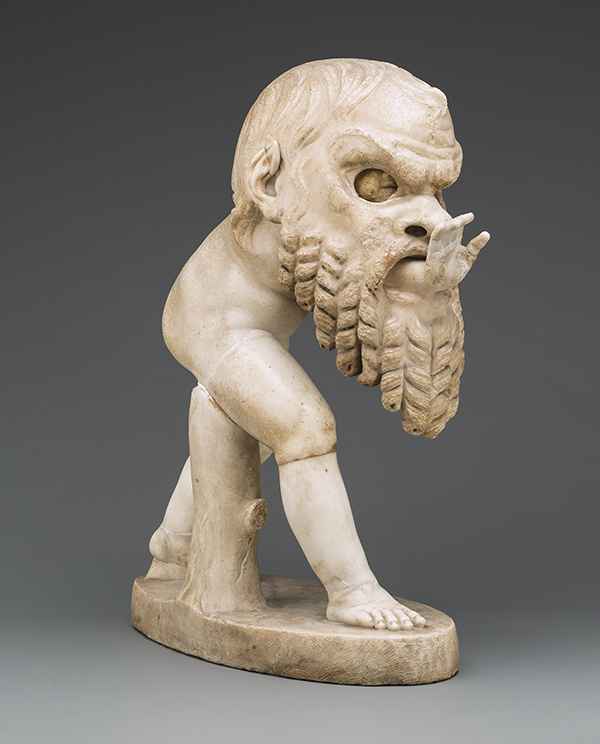
It's one of the most enigmatic sculptures at the Art Institute of Chicago. Nearly two-feet-tall, the Roman marble work depicts a striding nude—hidden, from the waist up, beneath the larger head of a bearded man. The giant face has hollowed-out eyes and a gaping mouth—through which a tiny hand reaches, as if waving, or just trying to feel its way around. Dating to the 1st century CE, the work was excavated in the early 1620s from the grounds of a villa, which occupied the site of ancient pleasure gardens planned by the historian Sallust.
It is undeniably weird. At a glance, the statue seems like a grotesque creature, perhaps a sculpted version of a monster from medieval marginalia. But look closer, and you'll spot a subtle grin beneath an eye socket, and see that the large face is actually held up by the figure's left hand. It's given name somewhat clarifies the scene: "Statue of a Young Satyr Wearing a Theater Mask of Silenos."
Because of its strange appearance, the statue's remained one of my favorite artworks under the museum's roof. I know I'm not alone. Every once in a while, a photo of it pops up on my social media feeds, although the responses can be mixed—especially when its title isn't noted. "Seriously fabulous and effed up sculpture," says Instagram user @kezinc. And on Twitter, via @kygrlinillinois: "That thing gives me nightmares."
Clearly, this object maintains its power to enthrall or unsettle. I wanted to learn more about its history and meaning, so I reached out to Karen Manchester, chair and curator of ancient art in the AIC's Department of Ancient and Byzantine Art.
What exactly is happening here…why is this figure sticking its hand through a giant mask?
Satyrs were mischievous followers of Dionysos, the ancient god of wine and theater, so it is not surprising to find one playing with a mask, which here represents the aged satyr Silenus. In other ancient artworks—like relief depictions of Dionysiac scenes carved in relief or incised—we sometimes encounter a similar composition in which a baby satyr thrusts his fist through the mouth of the mask and playfully frightens another little satyr standing opposite him. This little fellow probably once had a companion, but the two were separated at some point in the past.
The subject has human feet, and most of its torso is hidden. How do we know this is a satyr?
Excellent question. Satyrs were part human and part animal. We would think this is a chubby little child—except that the tiny tuft of tail emerging from its lower back clearly indicates that it's a satyr.
Were you able to identify its sculptor?
Because it was highly uncommon for ancient sculptors to chisel their names into statues, we don't know who carved this fascinating little fellow. But some areas of the sculpture are whiter than others; those are restorations made in the early 17th century by the renowned Italian sculptor Alessandro Algardi.
Do we know whom this sculpture was made for and where it might have been originally displayed?
No. We can't answer either question definitively. The high quality of the material and the workmanship tells us that its ancient owner was someone with the resources to employ a master sculptor to make the piece. As for its original placement, we speculate—but don't know for certain—that sculptures of this scale were displayed on bases or tables that allowed viewers to walk all the way around them.
Are you aware of any similar sculptures that date to this time, or is this a relatively unique artwork?
This is the only three-dimensional representation of the subject—or at least half of it—known to me from antiquity, so in that regard, yes, it is unique. But may I also draw your attention to an etching in the museum's collection made by Pierre Biard, II in 1629, which shows in it a little vignette in the lower-right corner a group of three little boys? The child on the left holds a similar mask (albeit upside down) to his face and similarly lunges toward a youth sitting on the back of another boy. I am tempted to think that the artist was inspired by an ancient artwork that he saw. In fact, it is not uncommon for me to come upon an artist sketching the sculpture in the gallery.
Speaking of the gallery, I love that the sculpture stands in such a prominent location. Tell me about the curatorial thinking behind the placement.
My decision to display the statue in its present location was multi-fold. First, all of the artworks in that gallery depict followers of the god Dionysos, who himself is represented in a rare, large-scale bronze statuette in the center of the space, so there's a thematic connection. But I chose that particular spot for this unusual young satyr in an effort to capture the attention of visitors entering the area from the Alsdorf gallery and headed toward either the Modern Wing or the Museum Café in the hope that it might capture their attention, and lead them to ask themselves many of the same questions that you've put to me here.



